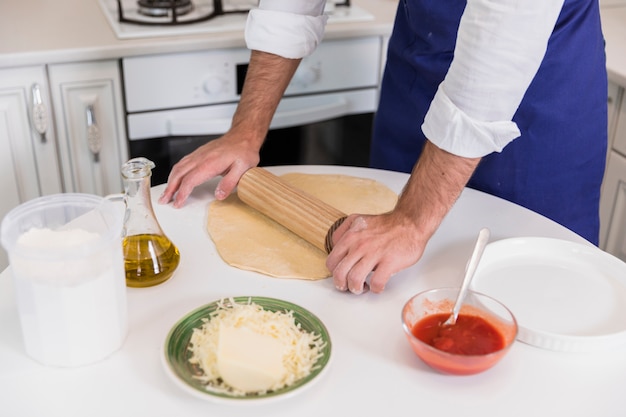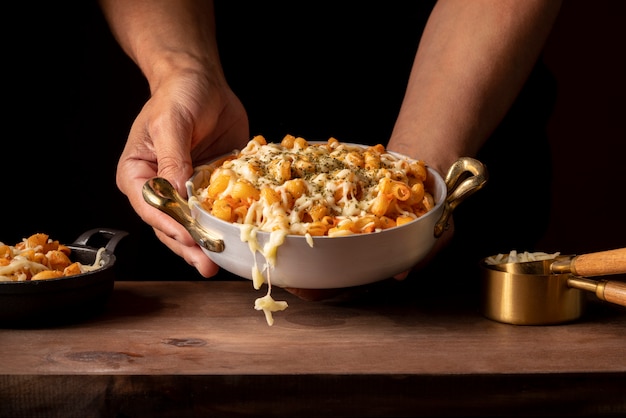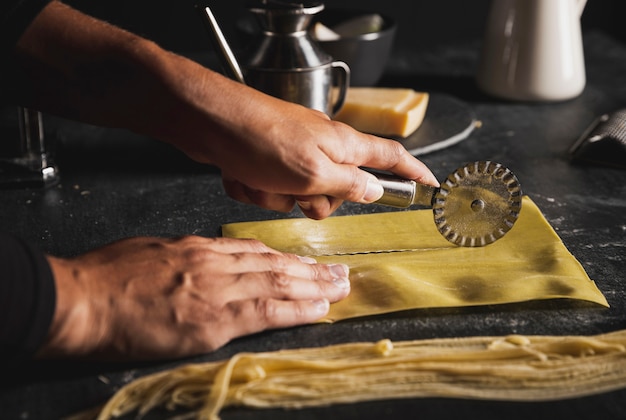Lasagna. Just the word conjures up images of bubbling, cheesy goodness, doesn't it? It's a dish that holds a special place in my heart, a comforting classic that always brings a smile to my face. But getting that lasagna just right, with perfectly cooked pasta, melted cheese, and a sauce that's simmered to perfection, can be a real challenge. One of the biggest hurdles people face is figuring out the right cooking temperature. Too low, and the pasta won't cook through. Too high, and everything risks burning before it's even had a chance to melt. So, buckle up, because I'm about to share my tried-and-true secrets to achieving that perfect lasagna cooking temperature, transforming your oven into a haven for culinary perfection.
Part 1: The Temperature Tango

The first thing you need to understand is that every oven is a bit of a personality, a unique character with its own quirks and temperaments. What works in your neighbour's kitchen might be a recipe for disaster in yours. So, ditch the blind faith in recipes and get to know your own oven. It's like getting to know a new friend, except this friend can make your food either wonderfully delicious or tragically burnt.
1.1 Unmasking Your Oven's Personality
Remember that time you forgot a pizza in the oven and it emerged looking like a charcoal briquette? Or maybe you baked a cake that sunk in the middle, a telltale sign of a cool oven? These little baking blunders are actually valuable clues to your oven's hidden personality. They're like breadcrumbs leading you towards that perfect lasagna cooking temperature. There are a couple of ways to truly understand your oven's temperament:
- The Trusty Oven Thermometer: This little gadget is your best friend, your confidante, your truth-teller. It'll reveal the true temperature of your oven, stripping away any illusions you might have about its accuracy.
- The Old-Fashioned Method: Grab a sheet of paper and place it in the oven. If it browns quickly, your oven is a hothead. If it takes ages to change colour, your oven is more of a cool cucumber.
Once you've got a grasp of your oven's personality, you can start tailoring the temperature to your lasagna. But the journey doesn't stop there, because the lasagna itself has its own quirks.
1.2 Layers of Complexity
The magic of lasagna lies in its layers, those perfectly stacked ribbons of pasta, sauce, and cheese. These layers aren't just about aesthetics, they influence how the heat travels, creating a whole new set of variables to consider. The more layers you have, the longer it takes for the heat to reach the heart of the lasagna, meaning you'll need a lower temperature to avoid burning the outer layers before the inside is cooked.
1.3 The Pasta Puzzle
Now, another key ingredient in this temperature puzzle is the type of pasta you're using. fresh pasta cooks faster than dried, meaning a slightly lower temperature might be your best bet to prevent it from becoming mushy. dried pasta, on the other hand, can take a little longer to soften up, so a slightly higher temperature might be necessary to get it tender and delicious.
Now that we've talked about the key players - your oven, your lasagna layers, and your pasta choice - let's dive into a specific guide for finding that perfect lasagna cooking temperature.
Part 2: The Temperature Guide

The beauty of lasagna lies in its versatility. It's a dish that can be dressed up for a fancy occasion or dressed down for a casual weeknight dinner. But no matter the occasion, you want to make sure your lasagna is cooked to perfection. That's where this temperature guide comes in, a cheat sheet of sorts to navigate the world of lasagna temperatures.
2.1 The Traditional Route
Most traditional lasagna recipes recommend a temperature between 180°C (350°F) and 200°C (400°F). This range is like the sweet spot for lasagna, allowing the pasta to cook through, the cheese to melt into a gooey delight, and the sauce to simmer and bubble without burning.
2.2 Fresh Pasta Adjustments
If you're using fresh pasta, the rules change slightly. You'll want to reduce the temperature by about 10°C (20°F) to prevent the pasta from overcooking and becoming mushy. Aim for a temperature around 170°C (340°F) for your fresh pasta lasagna.
2.3 The No-Bake Shortcut
For those who like to take a shortcut, there are no-bake lasagna recipes, a godsend for busy weeknights. These recipes often use pre-cooked pasta sheets, which means a lower temperature is required. Aim for a temperature around 160°C (325°F) for a no-bake lasagna.
2.4 The Deep Dish Dilemma
The shape of your baking dish can also influence the temperature you need. If you're using a deep dish, reduce the temperature by about 10°C (20°F). This is because the heat has to travel further to reach the centre of the dish. A slightly lower temperature ensures that your lasagna cooks evenly, with no burnt edges or undercooked centres.
But temperature isn't the only factor in the lasagna equation. Time is equally important, and it's time to explore the role it plays in crafting the perfect lasagna.
Part 3: The Time Element

Time is an essential ingredient in the lasagna recipe, just like salt or pepper. It takes time for the heat to penetrate those layers, for the pasta to soften, for the cheese to melt, and for the sauce to simmer to perfection. But how much time exactly?
3.1 The General Guideline
A good rule of thumb is to bake lasagna for around 30-45 minutes. But remember, this is just a starting point, a general guideline. The actual baking time will depend on the size of your lasagna, the thickness of the layers, and the temperament of your oven.
3.2 Signs of a Perfectly Cooked Lasagna
Here are a few telltale signs to look out for that signal the lasagna is ready to be devoured:
- The Pasta is Tender: Stick a fork into the centre of the lasagna. The pasta should be cooked through and tender, not hard or crunchy.
- The Cheese is Melted and Bubbly: The cheese should be melted all the way through and bubbly on top, creating a delightful, gooey layer.
- The Sauce is Simmering Gently: The sauce should be simmering, with a few bubbles on the surface, indicating that it's reached its peak of flavour.
3.3 The Cover Test: A Secret Weapon
The cover can be your secret weapon in the lasagna game. Covering your lasagna for the first part of the baking time helps to ensure even cooking and prevents the top from burning before the bottom is cooked. Then, you can uncover it for the last 15 minutes or so to let the top brown and get a lovely golden crust.
Speaking of that golden crust, let's talk about one of the most important players in the lasagna game - the cheese.
Part 4: The Cheese Factor
Cheese is practically a given in a good lasagna, isn't it? But it's more than just a cheesy topping, it plays a critical role in the lasagna's success. It not only adds flavour and texture, but it also helps to hold the lasagna together, giving it structure and preventing it from falling apart.
4.1 The Melting Point: A Key Consideration
Different cheeses have different melting points, a fact that often gets overlooked. Some melt quickly and smoothly, while others are more resistant, turning into a rubbery mess. For lasagna, you want a cheese that melts well and creates a nice, gooey layer, adding to the overall deliciousness.
4.2 Popular Cheese Choices: The Classics and Beyond
There are a few cheeses that are particularly popular for lasagna, the classic trio that brings a symphony of flavour to the dish:
- Mozzarella: This is the king of melting cheeses, creating a beautiful, stretchy layer that holds the lasagna together. Its slightly tangy flavour adds a touch of brightness.
- Ricotta: This soft, creamy cheese adds moisture and richness to the lasagna, balancing out the other flavours.
- Parmesan: This salty, nutty cheese adds a touch of crunch and depth of flavour to the lasagna.
Of course, you can always experiment with different cheese combinations, adding a touch of cheddar, provolone, or even a sprinkle of goat cheese. The world of cheese is your oyster, and there's no wrong answer, just different flavour profiles to explore.
4.3 The Cheese Layer: Less is More
You might be tempted to pile on the cheese, but less is actually more. A thin layer of cheese on top is all you need to create a beautiful crust. If you add too much cheese, it will become overcooked and chewy, ruining the delicate balance of your lasagna.
Now that we've covered the cheese, let's move on to another critical element of lasagna success - the sauce.
Part 5: The Sauce Situation
Let's face it, the sauce is the heart and soul of lasagna. It's what brings all the other ingredients together, creating a symphony of flavour that's both comforting and delicious. But the sauce can also influence the cooking temperature, adding another layer of complexity to the lasagna equation.
5.1 The Sauce Type: A World of Options
You have a world of options when it comes to lasagna sauce. You can use a simple tomato sauce, a meaty bolognese, a creamy white sauce, or even a vibrant pesto sauce. The type of sauce you choose will affect the cooking time. For example, a thick, meaty sauce will take longer to cook than a thinner tomato sauce.
5.2 The Sauce Consistency: Thick or Thin?
The consistency of the sauce matters as well. A thick sauce will take longer to cook than a thin sauce, so adjust the baking time accordingly.
5.3 The Sauce Quantity: The Goldilocks Rule
The amount of sauce you use can also affect the cooking time. Too much sauce can make the lasagna soggy, while too little sauce can make it dry. Aim for a good balance, finding that sweet spot where the sauce adds flavour and moisture without drowning the pasta.
5.4 The Sauce Tempering Trick: Preventing Soggy Pasta
Here's a little trick I learned from my grandma, a culinary sage who taught me the secrets of lasagna. Before adding your sauce to the lasagna, it's a good idea to temper it. This means adding a small amount of hot water or broth to the sauce, which helps to prevent the sauce from shocking the pasta and making it soggy. It's a simple step that makes a big difference in the final result.
Now, you might be thinking that we're done with the temperature and time, but there's one more crucial step - cooling down.
Part 6: The Cooling Off Period
This is a step that many people overlook, but it's incredibly important. Once your lasagna is cooked, it's essential to let it cool for at least 15 minutes before cutting into it. This allows the pasta to set and the cheese to firm up, preventing it from being mushy or falling apart. It's like giving the lasagna a chance to relax and regain its composure after its fiery ordeal in the oven.
But, how do you know when it's truly ready to be eaten, when it's reached its peak of culinary perfection?
Part 7: The Ultimate Test: A Symphony of Senses
It's not just about the temperature or the time. It's about the overall experience, a symphony of senses that tells you your lasagna is ready to be enjoyed. You know it's perfect when:
- The pasta is cooked through and tender. It should yield easily to a fork, melting in your mouth with every bite.
- The cheese is melted and bubbly. It should be a gooey, cheesy delight, with a few bubbly peaks adding a touch of visual appeal.
- The sauce is simmering and flavourful. It should be bubbling gently, releasing a tempting aroma that fills the air.
- The lasagna is golden brown and bubbling. The top should be beautifully browned, with a few bubbles indicating that it's reached its peak of deliciousness.
- It's got that irresistible aroma that fills the whole house. The smell of cooked lasagna is a sensory delight, filling you with anticipation for that first bite.
It's about that feeling of satisfaction, of knowing you've created something truly special, a culinary masterpiece that's sure to please even the most discerning palate.
Part 8: Tips and Tricks: Mastering the Lasagna Game
Here are a few more tips and tricks to elevate your lasagna game and ensure that every batch is a culinary triumph:
- Use a High-Quality Baking Dish: This will help to ensure even heat distribution, preventing those dreaded hot spots and uneven cooking.
- Grease the Baking Dish: This simple step prevents the lasagna from sticking to the bottom of the dish, ensuring a clean release and a beautiful presentation.
- Start with a Layer of Sauce: This helps to prevent the pasta from sticking to the bottom of the dish, creating a smooth and even base for your lasagna masterpiece.
- Don't Overcrowd the Dish: Give those lasagna layers some breathing room, allowing the heat to circulate evenly and preventing soggy layers.
- Don't Be Afraid to Experiment: Try different cheese combinations, sauces, and vegetables. Lasagna is a canvas for your culinary creativity, a chance to express your own unique flavour profile.
Now, I know what you're thinking. "This is a lot to take in!" But, trust me, it's worth it. You'll be amazed at the difference a few tweaks can make, transforming your lasagna from a good dish to a culinary masterpiece.
Part 9: Frequently Asked Questions: Lasagna FAQs
Let's address some of those burning lasagna questions that keep popping up in your mind.
9.1 Can I Use a Different Type of Pasta?
Absolutely! You can use other types of pasta, such as pappardelle or tagliatelle, but remember to adjust the cooking time accordingly. These pasta shapes have a larger surface area, meaning they might need a slightly longer cooking time to achieve that perfect tenderness.
9.2 Can I Make Lasagna Ahead of Time?
You can definitely make lasagna ahead of time, a lifesaver for busy schedules. Just assemble the layers, cover the dish with foil, and refrigerate it for up to 24 hours. Then, bake as directed. The lasagna will actually benefit from the rest, allowing the flavours to meld and deepen.
9.3 Can I Freeze Lasagna?
You can freeze lasagna before or after baking, giving you a delicious, homemade meal on hand whenever you need it. If you're freezing it unbaked, wrap it tightly in plastic wrap and foil. To freeze it baked, let it cool completely before wrapping it. When you're ready to enjoy it, thaw it overnight in the refrigerator and then reheat it in the oven or microwave.
9.4 How Do I Reheat Lasagna?
You can reheat lasagna in the oven, microwave, or on the stovetop. If you're reheating it in the oven, cover it with foil and bake at 175°C (350°F) until it's heated through. If you're using the microwave, make sure to cover it with a microwave-safe lid or plastic wrap to prevent it from drying out. For stovetop reheating, use a low heat and a covered pot to ensure even heating.
9.5 What Are Some Other Delicious Toppings for Lasagna?
You can get creative with your toppings, adding a touch of personality and flavour to your lasagna. Try adding fresh herbs, such as basil, parsley, or oregano. Roasted vegetables, like bell peppers, zucchini, or eggplant, add a vibrant touch of colour and flavour. And a drizzle of balsamic glaze adds a touch of sweetness and acidity, balancing out the richness of the lasagna.
Part 10: Conclusion: The Journey of Lasagna
So, there you have it. My guide to the perfect lasagna cooking temperature, a culmination of years of lasagna love and culinary experimentation. Remember, it's all about finding what works best for your oven, your ingredients, and your personal preferences. So, go on, unleash your inner chef and make a lasagna you'll be proud to serve. It's a journey of flavour, a celebration of comfort food, a testament to your culinary prowess.
Everyone is watching

Corn on the Cob: The Ultimate Guide to Perfectly Cooked Ears
Healthy MealsAh, corn on the cob. Just the name evokes images of sunny days, barbecues, and that sweet, juicy flavour that ...

Perfect Pork Roast Oven Cooking Time: A Guide to Delicious Results
Healthy MealsThere's something truly satisfying about a perfectly roasted pork. The aroma alone is enough to make your mout...

Ham Cooking Time: How Long to Bake, Smoke, or Boil a Delicious Ham
Healthy MealsAh, ham. It's a classic, isn't it? A real crowd-pleaser, especially around holidays. And when done right, it'...

Scallops: The Ultimate Guide to Perfect Cooking
Healthy MealsAh, scallops. Those delicate, sweet, and utterly delicious morsels of the sea. They hold a special place in my...

Spaghetti Squash: The Ultimate Guide to Cooking and Serving
Healthy MealsRemember that time you saw spaghetti squash at the supermarket, looking all bumpy and strange, and thought, "W...
